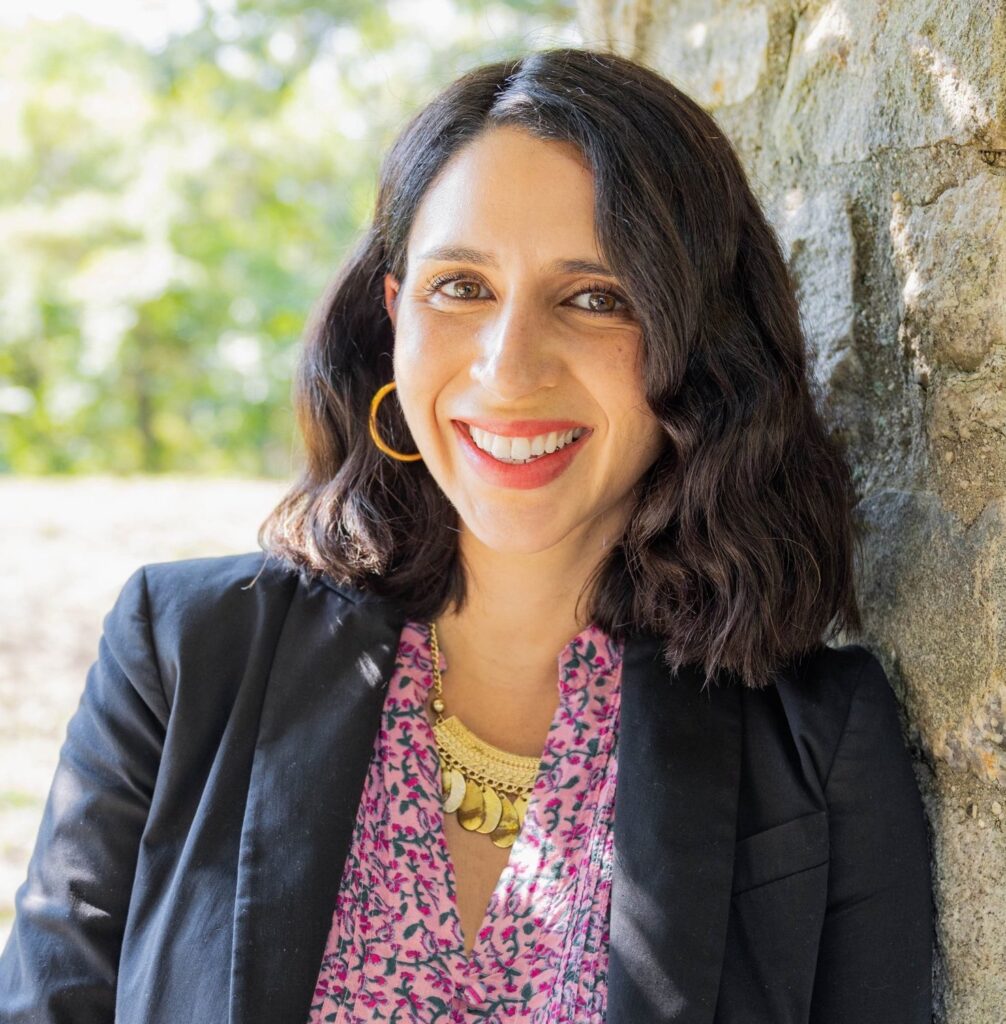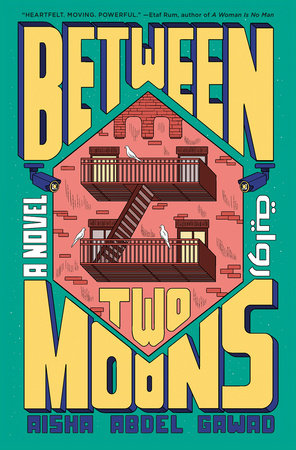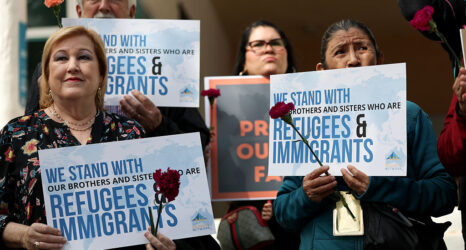“My hope is that Arabs and Muslims will feel seen.”

Aisha Abdel Gawad calls her first novel, Between Two Moons, “a love letter to Arab and Muslim communities.” The story centers around the Brooklyn-based Emam family: American-born twins Amira and Lina, their older brother Sami, and their parents, Mariam and Kareem.
It’s at once a highly specific story and a universal one, touching themes that include the gendered nature of coming-of-age and the impact of immigration on both U.S.-born children and their newcomer parents. The book also provides an incisive glimpse into what it means to live with political repression and the near-daily indignities of racial, religious and ethnic bias.
It’s an emotionally rich and revelatory portrait, set in a post 9/11 world that is still feeling the aftershocks of that unprecedented attack. But despite this grim overlay, humor and joy exist in the struggles Gawad documents. What’s more, love is ever present: between friends, between family members, and between each individual and the faith they cherish.
Gawad spoke to Ms. reporter Eleanor J. Bader several months before the book’s release.

Eleanor J. Bader: Bay Ridge, a neighborhood in Brooklyn, N.Y., is home to one of the country’s largest Muslim communities, with many immigrants from Egypt, Lebanon, Palestine and Yemen. Is this where you grew up?
Aisha Abdel Gawad: No. I grew up in northern Virginia, in a suburb of Washington, D.C., but I attended New York University and when I graduated in 2009, I wanted to stay in the city. I was able to find an AmeriCorps position with the Arab American Association of New York (AAANY), a grassroots organization in Bay Ridge and I fell in love with the neighborhood and the work AAANY does.
The workers are a lifeline for the community; it’s one of the first places people go when they’re newly arrived. They come to AAANY for everything, from help reading their mail, to help applying for a green card, to enrolling in English as a Second Language classes. The work is done with such humility. Being at AAANY gave me a closeness to my people that I had been craving. I worked there for a year and did youth programming.
Bader: Were you also writing?
Gawad: Yes. I’d started writing stories, or fragments of stories, and continued to work on them for more than a decade. They were the seeds for Between Two Moons. Bay Ridge was the setting for most of them and its streets and people remained in my imagination for the 11 years it took for the novel to come together.
Bader: I’m guessing that there were many drafts!
Gawad: When I started the stories, I was writing about two girls who were friends. Over time, I made them cousins, then sisters, then, finally, twins. I was really interested in the bonds, the closeness, between girls.
In some ways, the book reflects my own growth.I’m 35 now but I started writing the book when I was in my early 20s. At that point, I felt that, as a young Muslim woman, I was constantly being watched by the government. I felt as if I was seen as a potential enemy. As I wrote the book, I was also processing what it’s like to grow up feeling that way.
I was really interested in the bonds, the closeness, between girls.
Aisha Abdel Gawad
Bader: You arrived in Bay Ridge eight years after 9/11, but the novel illustrates the pervasive surveillance that was still going on at that time. Are the details you present accurate? If so, how did you learn so much about what the New York Police Department (NYPD) and FBI were doing to monitor Muslim/Arab communities?
Gawad: When I was at AAANY, it was well-known that the community was being watched and that there were plants, spies, in our neighborhoods. Then, in 2012, the Associated Press broke a story about an NYPD unit that was spying on Muslims. For a lot of Arabs and Muslims, this was vindication that we were not paranoid—that, in fact, we were constantly being watched. Worse, agents provocateur were trying to entrap people to commit crimes.
I devoured the documents that the AP uncovered and was shocked by the amount of detail. Reports listed the library books people checked out, the number of chairs in a cafe, and what channel played on their TVs. They even reported on the number of mattresses on the floor of apartments shared by recently-arrived immigrants.
Since the story was published, the surveillance unit has been shut down but we know that surveillance has not stopped. It has changed shape and form, but it continues. It’s as if everything Muslims and Arabs do is seen as menacing, suspicious.Law enforcement has used this suspicion to pressure people to become informants and spy on the community. People are scared. Since the Patriot Act was passed in October 2001, countless Muslims have been rounded up and imprisoned. Some have been held for years without charges. These prisons exist all over the U.S. and the abuses prisoners experience are similar to the abuses in Guantanamo.
As a community, we have asked ourselves what it means to be labeled a terrorist. The character of Faraj has been wrestling with this since his older brother was deported to Pakistan. Faraj maintains that his brother did nothing wrong and was never a threat or danger to the U.S. I hope readers will see Faraj as an example of a young American-born Muslim who feels betrayed by the promise of America. He is also at odds with his parents, who are in Pakistan, because they believe in the American dream and want him to prosper.
Bader: The fact that law enforcement entices people to snitch on one another is another story line in the novel. Writer Alexandra Natapoff’s 2022 book, Snitching: Criminal Informants and the Erosion of American Justice, estimates that the FBI and Drug Enforcement Agency utilize approximately 30,000 confidential informants. The novel demonstrates how this impacts Muslim/Arab communities. Can you say more about this?
Gawad: The FBI and police first used these tactics against the Black community so this is now a point of solidarity between Black and non-Black Muslim communities.
For Arabs, an important part of our culture is hospitality, welcoming strangers into our homes and mosques. The existence of informants has impacted this and we now wonder if a new person is safe or is a threat to us. Most people in the community see this as a violation of our heritage, and even though there are differences between, say, Yemenis and Egyptians, people have come together. Our targeting has been unifying since regardless of our ethnicity, we’re all seen as problems.
Bader: Has the community continued to organize opposition to surveillance and spying?
Gawad: When the news broke about NYPD infiltration, there was a lot of organized protest. Organizations such as the Council on American Islamic Relations and the American Civil Liberties Union spoke out. Some of that momentum has fizzled since the issue is no longer in the headlines and the NYPD unit is gone.
But just a few months ago, a European hacker found a 2019 No-Fly list and a shocking number of names on it sounded Arab or Muslim. This made clear that surveillance is by no means over.
Bader: The novel includes some heinous anti-Muslim violence directed at both an elderly Imam and a mosque where urine was poured throughout the space. Did the latter incident actually happen?
Gawad: Crimes directed at individuals and mosques have happened all over the country. I set the book in the month of Ramadan so this desecration happened in a holy place during a holy month. Mosques have been sites of contention since 9-11 and have been a focal point for Islamophobia for decades.
@knopfdoubledaybooks Aisha Abdel Gawad, author of BETWEEN TWO MOONS, on the challenges of celebrating Ramadan in the U.S. #booktok #books #bookworm #bookrecommendations #bookrecs #readinglist #readingrecs #muslim #muslimtiktok #ramadan #ramadanmubarak #americanmuslim #muslimauthors #arabtiktok #aishaabdelgawad #betweentwomoons ♬ Ramadan Mubarok – TonsTone
Bader: The different ways that boys and girls are socialized is another big theme in the novel. Lina and Amira could have benefited from comprehensive sex education, but no one seems to be providing this, not their public school and not community agencies. Is there any effort to change this?
Gawad: Unfortunately, there are still a lot of taboos regarding sexuality and talking about bodies more generally. This is not unique to Arabs or Muslims, of course, but it is still problematic. Lina is really self-destructive but she doesn’t feel like she can ask the questions that trouble her.
I teach English at an all-girls school and know that the students have deep inner lives but they can’t always express their thoughts, questions, and ideas. They know that there are looming threats out there and I think girls like Lina take risks because they live with a feeling of imminent violence and are trying to control it by inflicting danger on themselves.
At the same time, most kids can find models of healthy relationships and friendships that are open, supportive, and strong. I’ve been encouraged by comedian Ramy Youssef, whose TV show Ramy talks about the warped ideas some Muslim-Americans have absorbed on topics like dating, sexuality and relationships.
Bader: Mariam, the mother in the novel, has a lot of her own baggage regarding sexuality and family life, but it takes a crisis for her to share her experiences with her daughters. I found this quite moving.
Gawad: Mariam is trying to shelter her children from harm and eventually realizes that this is a mistake. I wanted her to be unable to see what her daughters are going through because she is so focused on her son’s pain. She was a hard character for me to write. I began the book long before I became a parent and it was only after I had my first child five years ago that I was able to fine-tune her character.
Bader: We haven’t spoken about Sami, the son in the story, yet. He’s a victim, a sort of tragic figure, betwixt and between.
Gawad: In creating Sami I wanted to explore what it’s like to be a Brown boy in America. He is not White and he is not Black which leaves him trying to figure out what’s possible for him. Many first-generation Americans—like me, Sami, Lina, Amira and Faraj—have been told that being in America means we can become whatever we want to become. When we discover that this is not true, we often become angry and I wanted the book to show that.
Boys, particularly emotional or sensitive boys, don’t always know how to express their feelings or their rage. I wanted Sami to be on his own with these feelings. His sisters have each other but Sami is pretty isolated. I wanted to show him wrangling with what it means to be loyal, what it means to be strong. When Sami comes back into Amira’s life, she is initially frightened, but as time passes, she wants to feed him and keep him safe. This was a big change for her.
Bader: Sami, Amira and Lina are also experimenting and trying on different identities.
Gawad: I wanted to show Muslim kids as typical teenagers who challenge at least some of the rules they’re given. I also wanted to show them trying to figure out how they feel about rule breaking. Furthermore, it was important to me that the girls find safety in their faith. These are people who have a deep relationship to Islam and who feel profoundly connected to it. No matter what else is happening in their lives, prayer is a source of support and comfort.
Bader: What do you hope readers take from the book?
Gawad: My hope is that Arabs and Muslims will feel seen. I wrote it from a place of love for a community that has gone through a lot of trauma over the past two decades. I hope non-Arab/Muslim readers might challenge some assumptions or ideas they’ve been taught about Muslims in America.
Up next:
U.S. democracy is at a dangerous inflection point—from the demise of abortion rights, to a lack of pay equity and parental leave, to skyrocketing maternal mortality, and attacks on trans health. Left unchecked, these crises will lead to wider gaps in political participation and representation. For 50 years, Ms. has been forging feminist journalism—reporting, rebelling and truth-telling from the front-lines, championing the Equal Rights Amendment, and centering the stories of those most impacted. With all that’s at stake for equality, we are redoubling our commitment for the next 50 years. In turn, we need your help, Support Ms. today with a donation—any amount that is meaningful to you. For as little as $5 each month, you’ll receive the print magazine along with our e-newsletters, action alerts, and invitations to Ms. Studios events and podcasts. We are grateful for your loyalty and ferocity.





